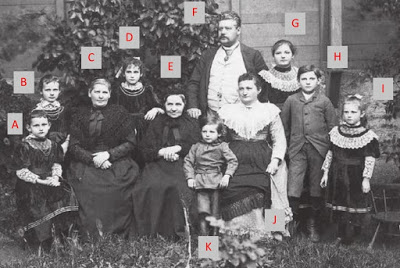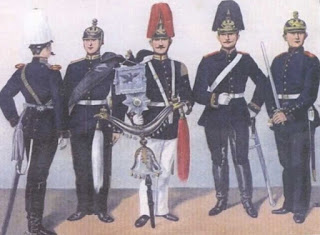It’s safe to say that Nazi Germany was not a stable place for thousands of Jews. The Nuremberg Laws progressively stripped away the civil rights of those who were classified as Jews (either 3 or 4 grandparents who had been born into the Jewish religion). Jewish doctors and lawyers could only have Jewish clients. Jews couldn’t attend the cinema. Jews were stripped of their German citizenship and banned from public office. Jews couldn’t own businesses or be employed at Aryan businesses. In such an atmosphere, it is little wonder that many Jews sought to escape Nazi Germany. The first wave of Jews fled to France, Belgium The Netherlands and Denmark in the mid-1930s. Others went to Austria and Czechoslovakia. None of those locations would provide safety once the Germans invaded those countries. By the late 1930s, erstwhile Jewish emigrants were becoming desperate, easy targets for the unscrupulous. “We can help you get out of Germany… for a price, of course.”
Josef Jakobs got involved with a group of unscrupulous opportunists who saw the plight of the Jews as a grand way to make money. During his interrogations by MI5 in 1941, Josef shared many details of the black market passport scheme of which he was a part, along with the names and personalities of his accomplices. A lawyer named Dr. Jürgen Ziebell was the mover and the shaker of the group. It was he who paid the bribes for Uruguayan, French or Cuban passports. But he needed clients, preferably rich clients and he relied on people like Josef to bring prosperous Jews to his offices at 202 Kurfürstendamm in Wilmersdorf, Berlin. The passports were apparently quite legal, just expensive.
Ziebell could get a passport for a client for around 22,000 Reich Marks (RM). People like Josef went out and advertised their services at a mark-up. They might say that a passport cost 30,000 RM, allowing them to pocket 8000 RM. It was apparently a lucrative business in 1938 and Ziebell had both Josef and a man named Egon Rammrath bringing him clients. While I haven’t found much on Ziebell, there is a fair bit on Rammrath.
Egon Clemens Pius Rammrath
Let’s start with the facts that we can glean from the genealogy websites. Egon Clemens Pius Rammrath was born on 11 July 1891 in Wilmersdorf to engineer and “Oekonomierat” Franz Josef Norbert Rammrath and his wife Henriette Clara Hedwig von der Heÿden.

From what I can gather, “Oekonomierat” was “an honorary title conferred upon a deserving agriculturist”. Franz and Hedwig lived at Brandenburgische Strasse #84 and were quite well off, owning a fair bit of land around Wilmersdorf. At that time, the village of Wilmersdorf was being absorbed into the city of Berlin. Farm fields gave way to large apartment blocks and landowners like Franz made a tidy penny.
Franz was a district-councillor for Wilmersdorf (as of 1907) and a member of the building commission that constructed the Tetlow Canal. He was apparently influential enough that one of the bridges over the Tetlow Canal was named after him – the Rammrath Brücke.

(From Wilmersdorf by Udo Christoffel – Sutton Verlag, 1998 – p. 96)
(from Google Books – hope link works)
Egon was their tenth child and they would have at least one more after him, for an even dozen. Of the twelve, at least two died as young children and there may have been others who perished as children or during World War I. Egon’s siblings were:
- Franz Josef August Rammrath b1878 – no marriage or death found in records (not in photograph – would have been 17-18 at the time)
- Norbert Franz Wilhelm Rammrath b1880 d1882 (deceased before photograph taken)
- Hedwig Clara Elisabeth (G in photograph) – b1881 – no marriage or death found in records
- Ernst Lucas ? Rammrath (H in photograph) – b1882 – no marriage or death found in records
- Eleonora Clara Franziska (D in photograph) – b1884 m1906 Josef Otto Hermann Maria Kerlë
- Elisabetha Josepha Margaretha Rammrath (A in photograph) – b1885 m1907 Bernhard August Steffen
- Klara Gertrud Franziska Rammrath (B in photograph) – b1886 m1915 Gustav Walter Fischer
- Auguste Martha Maria Rammrath (I in photograph) – b1888 m1913 Franz Joseph Leonhard Scheffels
- Catharina Carolina Hildegard Rammrath b1890 d1891 (deceased before photograph taken)
- Egon Clemens Pius Rammrath (K in photograph) – b1891 m1914
- Lothar Hubertus Heinrich Rammrath b1896 – no marriage or death (not born at time photograph was taken)
On 1 August 1914, Egon married Käthe Martha Olga Klinckmüller. Both of Egon’s parents were deceased by this point (his mother passed away in 1913 and his father between 1907-1914). Egon was living at Brandenburgische Strasse #53 and listed his occupation as “businessman”. A year later, the couple had apparently moved into Käthe’s home for Egon is listed in the telephone directory as living at Zähringerstrasse 25, Wilberforce. Given that Käthe’s father was deceased prior to their wedding, perhaps the young couple moved in with her mother.

Egon was 24 years old in 1915 and one could wonder why he had not already joined the German Army. He obviously did, for in 1920, he is once again listed in the Berlin phone books but this time as a businessman and a Lieutenant (Reserve) of the 1. Gard-Feld-Artillerie-Reg (1st Guard Field Artillery Regiment). His address is given as Kurfürstendamm 253, which is rather odd as that is right across from the Kaiser Wilhelm Gedächtnis Kirche. This could be explained by the fact that on 14 July 1922, Egon and his wife filed for divorce. Perhaps Egon’s return from war had not been such a success on the domestic front. A year later, in 1923, he was listed at the same address with the same occupation even though, by this point, the German Army had been demobilized as part of the armistice.
There is a gap in the phone directories available online and by 1940/1941, Egon was living at Meinekestrasse 8 and working as a “Werbefachm.” likely “Werbefachmann” – essentially an advertising/publicity man. Perhaps he saw his role in procuring wealthy clients for Ziebell as “publicity”?
Egon’s Loose Ends
There are also some loose ends around Egon. His birth registration form has three marginal notes. On March 20, 1930, a notary made a petition to the court in Charlottenburg stating that engineer Hugo Freiherr von Buchwald (a very aristocratic lineage), living in Charlottenburg, adopted Egon Rammrath and that henceforth Egon could use the family name, Freiherr von Buchwald, without needing to use his own family name (Rammrath). A rather odd note. Was Egon the child of Buchwald? Or had Buchwald sold his name to Rammrath? Perhaps a gambling debt? It didn’t last long in any event…
On 2 October, 1930, there is another marginal note that states the court in Charlottenburg determined on May 3, 1930, that the adoption was null and void and that the marginal note (granting use of the family name) had no power.
Four years later, on 27 August 1934, there is another marginal note which is convoluted in its legalese, to the point that I will need to consult a German cousin who is a notary/lawyer. It references some events in 1922 and 1933 and the use of a name (possibly Buchwald?). I’ll have to get back to you on this.
Egon’s marriage registration from 1914 also has a marginal note that states the couple received a divorce decree on 14 July 1922 and were divorced on 25 August 1922.

What became of Egon? Did he survive the war? I have found two references to articles written by an Egon Rammrath, one in 1946 and one in 1972. Is it him? Hard to say, although if it is, he would have been 81 years old at the time the second article was published in 1972. It does mention “werbung” which links to his career as a publicity/advertising guy in 1940/41.
The first article was published in Volume 2 No. 9 of Das Lichtblick, a cultural and entertainment magazine published out of Graz, Austria from 1945-1947. Hard to say if it was the same Egon Rammrath or not.
This then is what we can glean from genealogy files and other sources online. It’s not a lot but it does give us a framework for Egon’s life. Josef told MI5 quite a bit about Egon and I’ll expand on that in the next post. One could say that Josef’s tale about Egon adds some colour to this otherwise rather bland history.
N.B. 2020 – I tracked down Egon’s death registration, thanks to greater access to BMD records on Ancestry.
References
Ancestry – genealogy website – births, marriages, deaths, address books. I’ve created a Rammrath Tree in Ancestry, for my own ease in untangling all of the children. Contact me if you’re interested in seeing it.
YouTube – march of the 1. Gard-Feld-Artillerie-Reg (1st Guard Field Artillery Regiment)
Wikimedia – Rammrath Bridge over the Teltow Canal
Teltow Canal – Rammrath Bridge
